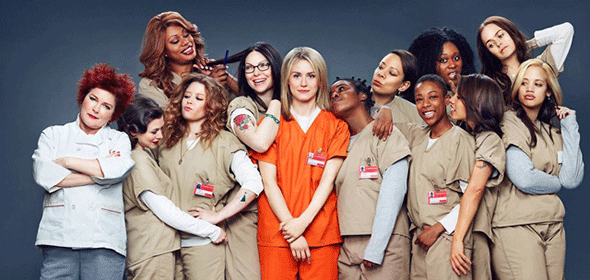
In a post Sex and the City world, many iterations of female leads have stormed our televisions and cinema, covering a tour-de-force of hilarious and raw subject matter. There’s the cringe worthy realities of Tina Fey’s brilliantly written and acted Mean Girls, to the next phase of life in girl-dom, the role of Bridesmaids, to the uncomfortably honest lives of the leads in Lena Dunham’s Girls. All of these female driven plots, however, have something in common: they all depict lily white, upper middle class trials and tribulations, from Manolo Blahniks to parents funding their post graduate rent in Brooklyn. Let’s be real: this isn’t even close to accessible for all women.
A new female led dramatic comedy, however, is gaining mainstream traction, and it isn’t what we’re used to seeing. Orange is the New Black, Netflix’s latest original programming, is a series about one woman’s brief foray into drug running and subsequent time served. This show stands out for it’s ability to finally (FINALLY!) demonstrate an intersectional portrayal of women. The primary setting is the prison, and the show often delves deeply into the lives of fellow inmates, which include blacks, latinas, and even a feisty Russian, of all ages.
Taylor Schilling, who plays Piper Chapman, does a fine job of portraying the timid, white upper middle class protagonist who in an alternate universe could have been friends with the Bridesmaids characters, or an older version of Marnie from HBO’s Girls. However, despite being the lead, Piper’s generally mousy demeanor facilitates the need for bold acting to support her. The ensemble does not disappoint. Piper’s fellow inmates are often hilarious, and always poignant amidst their struggles. Stand out performances include Laverne Cox, who plays transsexual Sophia, and is a real life transgender woman and activist. Also there’s Uzo Aduba, who plays Suzanne aka “Crazy Eyes”, whose performance is a truly enlightened take on mental illness.
Orange is the New Black is the first major win for intersectional feminism in mainstream pop culture. The irony is that it took a jailhouse setting to finally inject some color, literally and figuratively, into strong female leads. While this fact may seem unsettling, the show does an appropriate job of highlighting the inmates’ lives prior to jail, and humanizes the circumstances leading to their incarcerations. Additionally, the prison setting is offered as something of a great equalizer for these women of varying backgrounds. On the outside many of them function in differing cultural and socioeconomic environments, whereas in prison they are often forced to pool their resources against misogynist guards and substandard living conditions. As inmates, they are all wearing bland, state issued prison uniforms. This lack of materialism means we as an audience get to know these women for their personalities. Viewers are forced to critique the characters based on their words, a privilege rarely afforded to female characters.
Episodes include controversial and seldom covered topics ranging from homosexuality, race, age, class, and even patriarchal oppression through the eyes of this diverse cast. One episode centers around elections for inmate liaisons to the prison authority, except each candidate is elected based on race, by their own racial group. Another highlights the struggles of a poor, white, uneducated woman who clings to her religious convictions, racism, and homophobia, despite backlash from the more diverse and liberal prisoners.
Some argue that the show is another portrayal of racial and classist stereotypes: a transgender woman prioritizes her Hormone Replacement Therapy over her family, a Hispanic woman goes to jail for her drug dealing boyfriend, a black woman campaigns for fried chicken. Where stereotypes exist, however, there is also defiance: that same black woman is fluent in the law library, a homeless drug addict plans to pay back the people from which she stole, the aforementioned transgender woman befriends a nun. Orange is the New Black is not simply cut and dry stereotypes; the characters are far more dynamic, and more importantly, their perspectives are made accessible to those that cannot relate. Injecting these story lines in an easily attainable, mainstream show captures the very spirit of intersectionalism.
It is apparent that women have many hurdles yet to jump before female led casts become as ubiquitous as those of our male counterparts. But it is a testament to our boundless potential that these gritty female leads are literally locked in cages, relegated to a confined space and stripped of their clothes and makeup, only for audiences to realize how utterly beautiful, poignant, and entertaining they can be. We have not yet been released, but there is no doubt that Orange is the New Black is shaving time off our sentence.